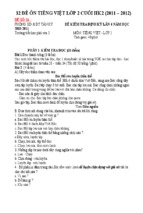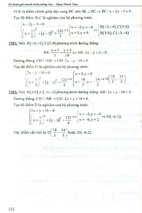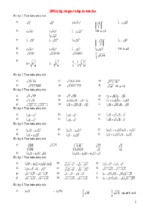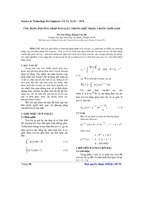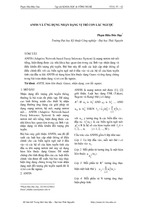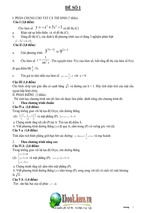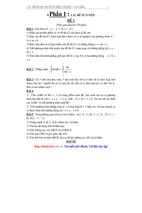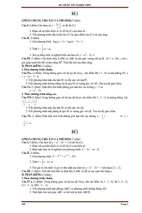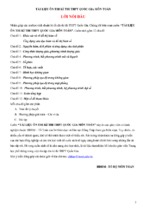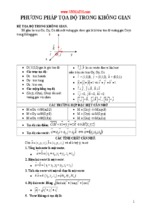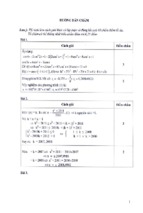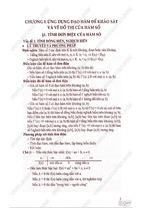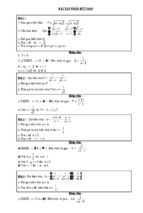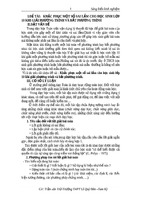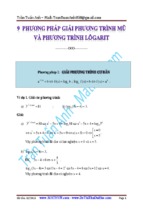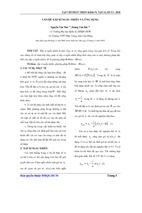C ONTENTS
Contents
i
Introduction
ii
1 Developing Math Intuition
1
2 The Pythagorean Theorem
7
3 Pythagorean Distance
14
4 Radians and Degrees
21
5 Imaginary Numbers
28
6 Complex Arithmetic
38
7 Exponential Functions & e
46
8 The Natural Logarithm (ln)
57
9 Interest Rates
62
10 Understanding Exponents
73
11 Euler’s Formula
81
12 Introduction To Calculus
90
Afterword
95
i
I NTRODUCTION
Let’s keep it simple: I want you to enjoy math. But the fun isn’t in using songs
to memorize formulas or doing contrived examples about ice cream cones. It’s
in the exhiliration of making an idea click for yourself.
The goal is to communicate like a real person, share insights, and be mercifully succinct. Let’s bring on the “aha!” moments!
Why Buy the Book?
If you have the book but didn’t buy it, purchase it at
http://betterexplained.com/ebook
There’s no DRM because that’s not what I’d want for myself. It’s your book
now: read it on your computer, Kindle, iPhone, or make a printout without a
hassle.
This work is a significant effort to format the content for ideal reading and
printing, along with new discussions tying the concepts together. There’s no
corporation or foundation here: I’m just a curious learner trying to improve
math education. These chapters would have saved me countless hours of frustration had they been available in school. If you haven’t already, please purchase the book to show your support.
How To Use This Book
This isn’t a reference or workbook. It’s about getting ideas to click; I want
concepts like e and i to be as natural to you as “a circle is round”. More
importantly, I want to spread the notion that any subject can be understood
intuitively if we find the right approach.
Here are a few practical ways to use the book:
• Entertainment: Yes, really. Math is fun when you see how ideas fit together and evolve. Did you know that negative numbers were only created in the 1700s, and were considered absurd? That imaginary numbers
had the same fight when introduced? Me neither.
• Study Supplement: If you’re a student, read this along with your textbook. Keep the analogies in your head as you do example problems to
see how they fit into place.
• Teaching Aid: Teachers, parents, and other educators: feel free to incorporate the text, analogies or diagrams into your learning materials.
Analogies and visualizations help enormously with puzzling concepts like
imaginary numbers. These chapters incorporate the feedback of many
thousands of readers.
ii
INTRODUCTION
iii
• Learn How to Learn: The essays highlight my favorite learning method:
get the context of an idea, formulate analogies, and cover examples using
those analogies. This learning technique works with many subjects, not
just math.
Feedback
Feedback and comments are welcome:
[email protected], or on the website at http://betterexplained.com/ebook.
Colophon
A
This book was typeset in LTEX using the excellent memoir package and a chapter style based on daleif1. While hairy at times, LaTeX is unmatched when
writing anything related to math.
The Legal Stuff
All content is copyright (c) 2009 Kalid Azad. You may use any of this material
for educational use with attribution; for commerical use, please contact me at
[email protected].
CHAPTER
1
D EVELOPING M ATH I NTUITION
Our initial exposure to an idea shapes our intuition. And our intuition impacts
how much we enjoy a subject. What do I mean?
Suppose we want to define a “cat”:
• Caveman definition: A furry animal with claws, teeth, a tail, 4 legs, that
purrs when happy and hisses when angry. . .
• Evolutionary definition: Mammalian descendants of a certain species
(F. catus), sharing certain characteristics. . .
• Modern definition: You call those definitions? Cats are animals sharing
the following DNA: ACATACATACATACAT. . .
The modern definition is precise, sure. But is it the best? Is it what you’d
teach a child learning the word? Does it give better insight into the “catness”
of the animal? Not really. The modern definition is useful, but after getting an
understanding of what a cat is. It shouldn’t be our starting point.
Unfortunately, math understanding seems to follow the DNA pattern. We’re
taught the modern, rigorous definition and not the insights that led up to it.
We’re left with arcane formulas (DNA) but little understanding of what the
idea is.
Let’s approach ideas from a different angle. I imagine a circle: the center
is the idea you’re studying, and along the outside are the facts describing it.
We start in one corner, with one fact or insight, and work our way around to
develop our understanding. Cats have common physical traits leads to Cats have
a common ancestor leads to A species can be identified by certain portions of DNA.
Aha! I can see how the modern definition evolved from the caveman one.
But not all starting points are equal. The right perspective makes math
click — and the mathematical “cavemen” who first found an idea often had an
enlightening viewpoint. Let’s learn how to build our intuition.
1.1
What is a Circle?
Time for a math example: How do you define a circle?
1
CHAPTER 1. DEVELOPING MATH INTUITION
2
There are seemingly countless definitions. Here’s a few:
• The most symmetric 2-d shape possible
• The shape that gets the most area for the least perimeter (the isoperimeter property)
• All points in a plane the same distance from a given point (drawn with a
compass, or a pencil on a string)
• The points (x,y) in the equation x 2 + y 2 = r 2 (analytic version of the geometric definition above)
• The points in the equation r · si n(t ), r · cos(t ), for all t (really analytic
version)
• The shape whose tangent line is always perpendicular to the position
vector (physical interpretation)
CHAPTER 1. DEVELOPING MATH INTUITION
3
The list goes on, but here’s the key: the facts all describe the same idea! It’s
like saying 1, one, uno, eins, “the solution to 2x + 3 = 5” or “the number of
noses on your face” — just different names for the idea of unity.
But these initial descriptions are important — they shape our intuition.
Because we see circles in the real world before the classroom, we understand
their “roundness”. No matter what fancy equation we see (x 2 + y 2 = r 2 ), we
know deep inside that a circle is round. If we graphed that equation and it
appeared square, or lopsided, we’d know there was a mistake.
As children, we learn the caveman definition of a circle (a really round
thing), which gives us a comfortable intuition. We can see that every point
on our “round thing” is the same distance from the center. x 2 + y 2 = r 2 is
the analytic way of expressing that fact (using the Pythagorean theorem for
distance). We started in one corner, with our intuition, and worked our way
around to the formal definition.
Other ideas aren’t so lucky. Do we instinctively see the growth of e , or is
it an abstract definition? Do we realize the rotation of i , or is it an artificial,
useless idea?
1.2
A Strategy For Developing Insight
I still have to remind myself about the deeper meaning of e and i — which
seems as absurd as “remembering” that a circle is round or what a cat looks
like! It should be the natural insight we start with.
Missing the big picture drives me crazy: math is about ideas — formulas
are just a way to express them. Once the central concept is clear, the equations
snap into place. Here’s a strategy that has helped me:
• Step 1: Find the central theme of a math concept. This can be difficult,
but try starting with its history. Where was the idea first used? What
was the discoverer doing? This use may be different from our modern
interpretation and application.
• Step 2: Explain a property/fact using the theme. Use the theme to
make an analogy to the formal definition. If you’re lucky, you can translate the math equation (x 2 + y 2 = r 2 ) into a plain-english statement (“All
points the same distance from the center”).
• Step 3: Explore related properties using the same theme. Once you
have an analogy or interpretation that works, see if it applies to other
properties. Sometimes it will, sometimes it won’t (and you’ll need a new
insight), but you’d be surprised what you can discover.
Let’s try it out.
1.3
A Real Example: Understanding e
Understanding the number e has been a major battle. e appears everywhere
in science, and has numerous definitions, yet rarely clicks in a natural way.
Let’s build some insight around this idea. The following section has several
CHAPTER 1. DEVELOPING MATH INTUITION
4
equations, which are simply ways to describe ideas. Even if the equation is
gibberish, there’s a plain-english concept behind it. Here’s a few common definitions of e :
The first step is to find a theme. Looking at e ’s history, it seems it has something to do with growth or interest rates. e was discovered when performing business calculations (not abstract mathematical conjectures) so “interest”
(growth) is a possible theme.
Let’s look at the first definition, in the upper left. The key jump, for me,
was to realize how much this looked like the formula for compound interest.
In fact, it is the interest formula when you compound 100% interest for 1
unit of time, compounding as fast as possible. The chapter on e describes this
interpretation.
• Definition 1: Define e as 100% compound growth at the smallest increment possible
Let’s look at the second definition: an infinite series of terms, getting smaller
and smaller. What could this be?
CHAPTER 1. DEVELOPING MATH INTUITION
e=
5
1 1 1 1
+ + + +···
0! 1! 2! 3!
After noodling this over using the theme of “interest” we see this definition shows the components of compound interest. Now, insights don’t come
instantly — this insight might strike after brainstorming “What could 1 + 1 +
1/2 + 1/6 + . . . ” represent when talking about growth?”
Well, the first term (1 = 1/0!, remembering that 0! is 1) is your principal,
the original amount. The next term (1 = 1/1!) is the “direct” interest you
earned — 100% of 1. The next term (0.5 = 1/2!) is the amount of money
your interest made (“2nd level interest”). The following term (.1666 = 1/3!)
is your “3rd-level interest” — how much money your interest’s interest earned!
Money earns money, which earns money, which earns money, and so on —
the sequence separates out these contributions (the chapter on e describes how
Mr. Blue, Mr. Green & Mr. Red grow independently). There’s much more to
say, but that’s the “growth-focused” understanding of that idea.
• Definition 2: Define e by the contributions each piece of interest makes
Neato. Now to the third, shortest definition. What does it mean? Instead of
thinking “derivative” (which turns your brain into equation-crunching mode),
think about what it means. The feeling of the equation. Make it your friend.
d
Bl ah = Bl ah
dx
It’s the calculus way of saying “Your rate of growth is equal to your current
amount”. Well, growing at your current amount would be a 100% interest rate,
right? And by always growing it means you are always calculating interest –
it’s another way of describing continuously compound interest!
• Definition 3: Define e as always growing by 100% of your current value
Nice — e is the number where you’re always growing by exactly your current amount (100%), not 1% or 200%.
Time for the last definition — it’s a tricky one. Here’s my interpretation:
Instead of describing how much you grew, why not say how long it took?
If you’re at 1 and growing at 100%, it takes 1 unit of time to get from 1 to
2. But once you’re at 2, and growing 100%, it means you’re growing at 2 units
per unit time! So it only takes 1/2 unit of time to go from 2 to 3. Going from
3 to 4 only takes 1/3 unit of time, and so on.
The time needed to grom from 1 to A is the time from 1 to 2, 2 to 3, 3 to
4. . . and so on, until you get to A. The first definition defines the natural log
(ln) as shorthand for this “time to grow” computation.
l n(a) is simply the time to grow from 1 to a. We then say that e is the
number that takes exactly 1 unit of time to grow to. Said another way, e is is
the amount of growth after waiting exactly 1 unit of time!
• Definition 4: Define the time needed to grow continuously from 1 to as
l n(a). e is the amount of growth you have after 1 unit of time.
CHAPTER 1. DEVELOPING MATH INTUITION
6
Whablamo! These are four different ways to describe the mysterious e.
Once we have the core idea (“e is about 100% continuous growth”), the crazy
equations snap into place — it’s possible to translate calculus into English.
Math is about ideas!
1.4
What’s the Moral?
In math class, we often start with the last, most complex idea. It’s no wonder
we’re confused: we’re showing students DNA and expecting them to see a cat.
I’ve learned a few lessons from this approach, and it underlies how I understand and explain math:
• Search for insights and apply them. That first intuitive insight can help
everything else snap into place. Start with a definition that makes sense
and “walk around the circle” to find others.
• Be resourceful. Banging your head against an idea is no fun. If it doesn’t
click, come at it from different angles. There’s another book, another
article, another person who explains it in a way that makes sense to you.
• It’s ok to be visual. We think of math as rigid and analytic — but visual
interpretations are ok! Do what develops your understanding. Imaginary
numbers were puzzling until their geometric interpretation came to light,
decades after their initial discovery. Looking at equations all day didn’t
help mathematicians “get” what they were about.
Math becomes difficult and discouraging when we focus on definitions over
understanding. Remember that the modern definition is the most advanced
step of thought, not necessarily the starting point. Don’t be afraid to approach
a concept from a funny angle — figure out the plain-English sentence behind
the equation. Happy math.
CHAPTER
2
T HE P YTHAGOREAN T HEOREM
The Pythagorean theorem (a 2 + b 2 = c 2 ) is a celebrity: if an equation can make
it into the Simpsons, I’d say it’s well-known.
But most of us think the formula only applies to triangles and geometry.
Think again. The Pythagorean Theorem can be used with any shape and for
any formula that squares a number.
Read on to see how this 2500-year-old idea can help us understand computer science, physics, even the value of Web 2.0 social networks.
2.1
Understanding How Area Works
I love seeing old topics in a new light and discovering the depth there. For
example, I realize I didn’t have a deep grasp of area until writing this chapter.
Yes, we can rattle off equations, but do we really understand the nature of area?
This fact may surprise you:
• The area of any shape can be computed from any line segment squared
In a square, our “line segment” is usually a side, and the area is that side
squared (side 5, area 25). In a circle, the line segment is often the radius, and
the area is πr 2 (radius 5, area 25π). Easy enough.
We can pick any line segment and figure out area from it: every line segment has an “area factor” in this universal equation:
Ar ea = F ac t or · (l i ne seg ment )2
7
CHAPTER 2. THE PYTHAGOREAN THEOREM
Shape
Image
8
Line Segment
Area
Area Factor
Square
Side [s]
s2
1
Square
Perimeter [p]
1 2
16 p
1
16
Square
Diagonal [d]
1 2
2d
1
2
Circle
Radius [r]
πr 2
π(3.14...)
For example, look at the diagonal of a square (“d”). A regular side is d / 2,
1
so the area becomes 2 d 2 . Our “area contant” is 1/2 in this case, if we want to
use the diagonal as our line segment to be squared.
Now, use the entire perimeter (“p”) as the line segment. A side is p/4, so
the area is p 2 /16. The area factor is 1/16 if we want to use p 2 .
2.2
Can We Pick Any Line Segment?
You bet. There is always some relationship between the traditional line segment
(the side of a square), and the one you pick (the perimeter, which happens to
be 4 times a side). Since we can convert between the “traditional” and “new”
segment, it doesn’t matter which one we use – there’ll just be a different area
factor when we multiply it out.
2.3
Can We Pick Any Shape?
Sort of. A given area formula works for all similar shapes, where “similar”
means “zoomed versions of each other”. For example:
• All squares are similar (area always s 2 )
• All circles are similar, too (area always πr 2 )
CHAPTER 2. THE PYTHAGOREAN THEOREM
9
• All triangles are not similar: Some are fat and others skinny – every type
of triangle has its own area factor based on the line segment you are
using. Change the shape of the triangle and the equation changes.
Yes, every triangle follows the rule ar ea = 1 base · hei g ht . But the relation2
ship between base and height depends on the type of triangle (base = 2·hei g ht ,
base = 3 · hei g ht , etc.), so even then the area factor will be different.
Why do we need similar shapes to keep the same area equation? Intuitively,
when you zoom (scale) a shape, you’re changing the absolute size but not
the relative ratios within the shape. A square, no matter how zoomed, has a
perimeter = 4 · si d e .
Because the area factor is based on ratios inside the shape, any shapes with
the same ratios will follow the same formula. It’s a bit like saying everyone’s
armspan is about equal to their height. No matter if you’re a NBA basketball
player or child, the equation holds because it’s all relative. (This intuitive
argument may not satisfy a mathematical mind – in that case, take up your
concerns with Euclid).
I hope these high-level concepts make sense:
• Area can be be found from any line segment squared, not just the side or
radius
• Each line segment has a different “area factor”
• The same area equation works for similar shapes
For the geeks: why do all similar shapes have the same area factor? Here’s
my intuition:
Scaled versions of the same shape have the same ratios. Why?
When we move an object, the apparent size might change (a stop
sign close up vs. far away) but it seems the ratios should stay the
same. Can an object know it’s being viewed from afar and modify
the ratio of side to area?
Consider two similar shapes. Push away the larger until it’s the
same apparent size as the smaller. Now they look identical, and
therefore have the same ratios (area to perimeter, etc.). Now pull
in the larger one. The shape appears bigger, but its ratios haven’t
changed during the move – they’re the same as the smaller shape.
Here’s one reader’s (Per Vognsen) more formal proof:
You just have to prove that L 2 /A is constant within a similarity class.
Take two members of the same similarity class, of areas A and A’ and
lengths L and L’. Let F be the factor of the dilation that maps the
first figure onto the other. Then A = F 2 ∗ A and L = F ∗ L . Squaring
the length equation gives L 2 = F 2 ∗ L 2 . Dividing the area equation
by this, the F 2 factors cancel, yielding A/L 2 = A /L 2 . So the area to
squared length ratio is indeed constant.
CHAPTER 2. THE PYTHAGOREAN THEOREM
2.4
10
Intuitive Look at The Pythagorean Theorem
I think we can all agree the Pythagorean Theorem is true. But most proofs offer
a mechanical understanding: re-arrange the shapes, and voila, the equation
holds. But is it really clear, intuitively, that it must be a 2 + b 2 = c 2 and not
2a 2 + b 2 = c 2 ? No? Well, let’s build some intuition.
There’s one killer concept we need: Any right triangle can be split into
two similar right triangles.
Cool, huh? Drawing a perpendicular line through the point splits a right triangle into two smaller ones. Geometry lovers, try the proof yourself: use angleangle-angle similarity.
This diagram also makes something very clear:
Ar ea(Bi g ) = Ar ea(Med i um) + Ar ea(Smal l )
Makes sense, right? The smaller triangles were cut from the big one, so the
areas must add up. And the kicker: because the triangles are similar, they have
the same area equation.
Let’s call the long side c (5), the middle side b (4), and the small side a (3).
Our area equation for these triangles is:
Ar ea = F · h y pot enuse 2
where F is some area factor (6/25 or .24 in this case; the exact number
doesn’t matter). Now let’s play with the equation:
Ar ea(Bi g ) = Ar ea(Med i um) + Ar ea(Smal l )
F · c 2 = F · b2 + F · a2
Divide by F on both sides and you get:
c 2 = b2 + a2
Which is our famous theorem! You knew it was true, but now you know
why:
• A triangle can be split into two smaller, similar ones
CHAPTER 2. THE PYTHAGOREAN THEOREM
11
• Since the areas must add up, the squared hypotenuses (which determine
area) must add up as well
This takes a bit of time to see, but I hope the result is clear. How could the
small triangles not add to the larger one?
Actually, it turns out the Pythagorean Theorem depends on the assumptions
of Euclidean geometry and doesn’t work on spheres or globes, for example. But
we’ll save that discussion for another time.
2.5
Useful Application: Try Any Shape
We used triangles in our diagram, the simplest 2-D shape. But the line segment
can belong to any shape. Take circles, for example:
Now what happens when we add them together?
CHAPTER 2. THE PYTHAGOREAN THEOREM
12
You guessed it: Circle of radius 5 = Circle of radius 4 + Circle of radius 3.
Pretty wild, eh? We can multiply the Pythagorean Theorem by our area
factor (π, in this case) and come up with a relationship for any shape.
Remember, the line segment can be any portion of the shape. We could
have picked the circle’s radius, diameter, or circumference – there would be a
different area factor, but the 3-4-5 relationship would still hold.
So, whether you’re adding up pizzas or Richard Nixon masks, the Pythagorean
theorem helps you relate the areas of any similar shapes. Now that’s something
they didn’t teach you in grade school.
2.6
Useful Application: Conservation of Squares
The Pythagorean Theorem applies to any equation that has a squared term.
The triangle-splitting means you can split any amount (c 2 ) into two smaller
amounts (a 2 + b 2 ) based on the sides of a right triangle. In reality, the “length”
of a side can be distance, energy, work, time, or even people in a social network.
Social Networks
Metcalfe’s Law (if you believe it) says the value of a network is about n2 (the
number of relationships). In terms of value,
• Network of 50M = Network of 40M + Network of 30M.
Pretty amazing – the 2nd and 3rd networks have 70M people total, but they
aren’t a coherent whole. The network with 50 million people is as valuable as
the others combined.
CHAPTER 2. THE PYTHAGOREAN THEOREM
13
Computer Science
Some programs with n inputs take n 2 time to run (bubble sort, for example).
In terms of processing time:
• 50 inputs = 40 inputs + 30 inputs
Pretty interesting. 70 elements spread among two groups can be sorted as
fast as 50 items in one group. (Yeah, there may be constant overhead/start up
time, just work with me here).
Given this relationship, it makes sense to partition elements into separate
groups and then sort the subgroups. Indeed, that’s the approach used in quicksort, one of the best general-purpose sorting methods. The Pythagorean theorem helps show how sorting 50 combined elements can be as slow as sorting
30 and 40 separate ones.
Surface Area
The surface area of a sphere is 4πr 2 . So, in terms of surface area of spheres:
• Area of radius 50 = Area of radius 40 + Area of radius 30
We don’t often have spheres lying around, but boat hulls may have the
same relationship (they’re like deformed spheres, right?). Assuming the boats
are similarly shaped, the paint needed to coat one 50 foot yacht could instead
paint a 40 and 30-footer. Yowza.
Physics
If you remember your old physics classes, the kinetic energy of an object with
mass m and velocity v is 1 mv 2 . In terms of energy,
2
• Energy at 500 mph = Energy at 400 mph + Energy at 300 mph
With the energy used to accelerate one bullet to 500 mph, we could accelerate two others to 400 and 300 mph.
2.7
Enjoy Your New Insight
Throughout our school life we think the Pythagorean Theorem is about triangles and geometry. It’s not.
When you see a right triangle, realize the sides can represent the lengths of
any portion of a shape, and the sides can represent variables in any equation
that has a square. Maybe it’s just me, but I find this pretty surprising.
There’s much, much more to this beautiful theorem, such as measuring any
distance. Enjoy.
CHAPTER
3
P YTHAGOREAN D ISTANCE
We’ve underestimated the Pythagorean theorem all along. The previous chapter showed it’s not about triangles; it can apply to any shape. It’s not about a,
b and c; it applies to any formula with a squared term.
It’s not about distance in the sense of walking diagonally across a room.
It’s about any distance, like the “distance” between our movie preferences or
colors.
If it can be measured, it can be compared with the Pythagorean Theorem.
Let’s see why.
3.1
Understanding The Theorem
We agree the theorem works. In any right triangle:
If a=3 and b=4, then c=5. Easy, right? Well, a key observation is that a
and b are at right angles (notice the little red box). Movement in one direction
has no impact on the other.
It’s a bit like North/South vs. East/West. Moving North does not change
your East/West direction, and vice-versa — the directions are independent (the
geek term is orthogonal).
The Pythagorean Theorem lets you find the shortest path distance between
orthogonal directions. So it’s not really about right “triangles” — it’s about
comparing “things” moving at right angles.
You: If I walk 3 blocks East and 4 blocks North, how far am I from
my starting point?
Me: 5 blocks, as the crow flies. Bring adequate provisions for your
14
CHAPTER 3. PYTHAGOREAN DISTANCE
15
journey.
You: Uh, ok.
3.2
So What Is “c”?
Well, we could think of c as just a number, but that keeps us in boring triangleland. I like to think of c as a combination of a and b.
But it’s not a simple combination like addition — after all, c doesn’t equal a
+ b. It’s more a combination of components — the Pythagorean theorem lets
us combine orthogonal components in a manner similar to addition. And there’s
the magic.
In our example, C is 5 blocks of “distance”. But it’s more than that: it
contains a combination of 3 blocks East and 4 blocks North. Moving along C
means you go East and North at the same time. Neat way to think about it, eh?
3.3
Chaining the Theorem
Let’s get crazy and chain the theorem together. Take a look at this:
Cool, eh? We draw another triangle in red, using c as one of the sides. Since
c and d are at right angles (orthogonal!), we get the Pythagorean relation:
c 2 + d 2 = e 2.
And when we replace c 2 with a 2 + b 2 we get:
a2 + b2 + d 2 = e 2
And that’s something: We’ve written e in terms of 3 orthogonal components
(a, b and d). Starting to see a pattern?
CHAPTER 3. PYTHAGOREAN DISTANCE
3.4
16
Put on Your 3D Goggles
Think two triangles are strange? Try pulling one out of the paper. Instead of
lining the triangles flat, tilt the red one up:
It’s the same triangle, just facing a different way. But now we’re in 3d! If
we call the sides x, y and z instead of a, b and d we get:
x 2 + y 2 + z 2 = d i st ance 2
Very nice. In math we typically measure the x-coordinate (left/right distance), the y-coordinate (front-back distance), and the z-coordinate (up/down
distance). And now we can find the 3-d distance to a point given its coordinates!
3.5
Use Any Number of Dimensions
As you can guess, the Pythagorean Theorem generalizes to any number of dimensions. That is, you can chain a bunch of triangles together and tally up the
“outside” sections:
You can imagine that each triangle is in its own dimension. If segments are
at right angles, the theorem holds and the math works out.

